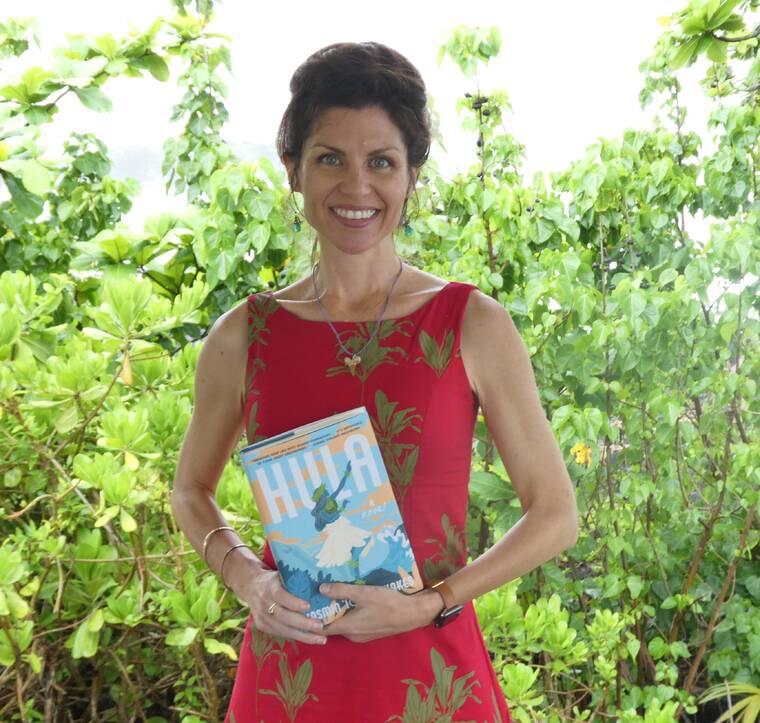Seldom has the first novel by an author from Hawaii been as eagerly anticipated as “Hula” by Jasmin ‘Iolani Hakes.
The novel, published by HarperVia, a subsidiary of HarperCollins, is slated for release on Tuesday.
“Hula” is a work of fiction, but is loosely derived from Hakes’ experiences as a light-skinned child growing up in Keaukaha in a home where a picture of hula master ‘Iolani Luahine was at the front door, confronting her every time she left the house.
“It’s actually less autobiographical than I thought, at first,” said Hakes, a 43-year-old mother of two who now lives in Southern California.
She spoke to the Tribune-Herald during Merrie Monarch week, just prior to a book blessing at Wai‘uli Beach Park, also known as Leleiwi beach. Performing the blessing was Patrick “Uncle Pat” Kahawaiola‘a, president of the Keaukaha Community Association.
“My mom was reminding me, when we were trying to figure out how to conceptualize a book blessing, that we know how to bless a marriage and a new baby and a new business. We have to bless it at Wai‘uli. My mom said the entire time she was pregnant with me, she was floating in there,” Hakes said, pointing to the shore break.
“I grew up going to Richardson’s and Wai‘uli, so it felt appropriate to start it here.”
While Hakes’ childhood home isn’t in the Hawaiian Homes section of Keaukaha, the novel’s three main characters — Hulali Naupaka, a kumu hula; her daughter, Laka, a Miss Aloha Hula; and Laka’s white-skinned daughter, Hi‘i, whose origins are concealed by Laka — live in a homestead house. Racial identity and blood quantum for Hawaiian Homes eligibility play a role in the plot.
In addition, Hi‘i desperately wants to perpetuate the family’s hula dynasty. She yearns to be accepted as Hawaiian while others, including some family members, plant seeds of doubt within her as to whether she belongs.
Hakes, whose skin tone is closer to her California surfer father’s than that of her mother — who grew up in a Filipino sugar camp and whom Hakes said “will dance on top of a table at the drop of a hat” — from age 4 danced for Halau O Kekuhi, the prestigious halau of the Edith Kanaka‘ole Foundation.
Later she joined the Tahitian dance troupe Hei Tiare. Hakes partially financed her college education by dancing Tahitian at lu‘aus in the Waikoloa resort area.
“I think, for my mom, she was given this prophecy of me being a hula dancer,” Hakes said. “And when I left hula, I kind of had to reconcile that, a little bit. And with Tahitian, I found a family.
“We were performing and doing everything that Halau O Kekuhi wasn’t at the time. It was just kind of light fun, and I felt that my skin and what I looked like wasn’t as much of a thing.”
“And I don’t think that came from Halau O Kekuhi,” Hakes added, quickly. “I think that was internal, just this expectation and this image of what a hula dancer looked like, because it was so traditional.”
Hakes said when her parents separated, she moved to California but spent her summers in Hilo.
“I came back in 1992, so I was in middle school and went back to Halau O Kekuhi. And that was, I think, when I started feeling very self-conscious. And all of the questions about what I looked like really came to a head. It was mostly my eyes,” she said. “I was born in a little shack on Ohai Street. It was my mom’s 30th birthday party, so the joke was if she hadn’t given birth at home in front of a bunch of witnesses, she would’ve never believed (I) was hers.
“And down here, I was the white ‘Where’s Waldo,’” Hakes continued. “You know, all the cousin pictures of us down at Richardson’s, naked, and I was just white. So I felt very self-conscious going into adolescence. And at Halau O Kekuhi, I think my middle name always struck me subconsciously as something I kind of needed to live up to, you know?”
The novel deftly glides back and forth in time from 1968 to 1996, with narrative backdrops mostly true to the time’s history.
A graduate of Waiakea High School’s Class of 1997, Hakes credited Scott Roberts, a now-retired English teacher, as “the first to insinuate that I might have something” as a writer.
“I’d turn in a paper, and he’d write on it, ‘Don’t bull—-t me. You can do better than that,’” she said. “… That was the first time I really saw that I had a strength in putting something to paper.”
This is Hakes’ first novel, but she’s won several awards for shorter works. She’s published essays in the Los Angeles Times and Sacramento Bee. And she has completed a memoir that will be published in the near future.
Her next project, which she’s finished researching, is a nonfiction work about a number of Hawaiians who were employed by John Sutter, a Swiss immigrant who gained historical fame as a prominent figure during the California gold rush of the mid 1800s.
The plaudits for “Hula” are already rolling in on a national scale. It’s on Oprah’s Book Club’s spring reading list and Elle’s “The 39 Best New Books to Read in Summer 2023.”
“I can’t believe I get to do this for a living,” Hakes marveled. “I understand and appreciate just how privileged I am.”
Email John Burnett at jburnett@hawaiitribune-herald.com.






